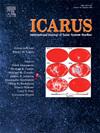Pediment formation and subsequent erosion in Gale crater: Clues to the climate history of Mars
IF 2.5
2区 物理与天体物理
Q2 ASTRONOMY & ASTROPHYSICS
引用次数: 0
Abstract
Evidence of paleo-rivers, fans, deltas, lakes, and channel networks across Mars has prompted much debate about what climate conditions would permit the formation of these surface water derived features. Pediments, gently sloping erosional surfaces of low relief developed in bedrock, have also been identified on Mars. On Earth, these erosional landforms, often thought to be created by overland flow and shallow channelized runoff, are typically capped by fluvial sediments, and thus in exceptionally arid regions, pediments are interpreted to record past wet periods. Here we document the Greenheugh pediment in Gale crater, exploiting the observational capability of the Curiosity rover. The absence of a fluvial cap suggests that the pediment was likely cut by wind erosion, not fluvial processes. The pediment was then buried by an aeolian deposit (Stimson sandstone) that mantled the lower footslopes of Aeolis Mons (informally known as Mt. Sharp). This burial terminated active wind erosion, preserving the pediment surface (as an angular unconformity). Groundwater was present prior-to, during, and shortly after Stimson deposition, perhaps contributing to lithification and certainly to early diagenesis. Post lithification, wind erosion first cut canyons in the northern most footslopes (north of Vera Rubin ridge). Unlithified gravels were deposited in these canyons, likely due to runoff from Mt. Sharp. Boulder-rich fluvial and debris flow deposits built a > 70 m thick sequence (Gediz Vallis ridge) on the southern Greenheugh pediment. Continued wind erosion left elevated patches of gravel on the northern footslopes, and exposure age dating shows that erosion essentially ceased before 1 Ga (but possibly much earlier). Erosion to the south led to emergence of Vera Rubin ridge, retreat of the Greenheugh pediment, and the formation of Glen Torridon valley. Hence, this footslope environment of Mt. Sharp records climate-driven periods of wind erosion, aeolian deposition (and groundwater activity), surface runoff and sediment deposition, followed by further significant wind erosion that declined to present very slow rates. This likely occurred during the late Hesperian and possibly into the Amazonian.
盖尔陨石坑中山形墙的形成和随后的侵蚀:火星气候历史的线索
遍布火星的古河流、扇、三角洲、湖泊和水道网的证据引发了关于什么样的气候条件会允许这些地表水特征形成的争论。在火星上也发现了山墙,即在基岩中形成的缓坡侵蚀面。在地球上,这些侵蚀地貌通常被认为是由陆地上的水流和浅河道化的径流形成的,它们通常被河流沉积物覆盖,因此在异常干旱的地区,山墙被解释为记录了过去的湿润时期。在这里,我们记录了盖尔陨石坑的格林休山形,利用了好奇号火星车的观测能力。没有河帽表明,山形墙可能是由风蚀造成的,而不是河流的作用。山形墙随后被风成沉积物(斯廷森砂岩)所掩埋,风成沉积物覆盖了风成山(俗称夏普山)较低的脚坡。这种埋葬终止了活跃的风蚀,保留了山形墙表面(作为一个角度不整合)。地下水在斯廷森沉积之前、期间和之后不久都存在,可能有助于岩化作用,当然也有助于早期成岩作用。岩化后,风蚀首先在最北部的脚坡(维拉鲁宾山脊以北)切割峡谷。未石化的砾石沉积在这些峡谷中,可能是由于夏普山的径流。富抱石的河流和泥石流沉积形成了70米厚的序列(Gediz Vallis山脊)在格林休山形墙的南部。持续的风蚀在北部的脚坡上留下了凸起的砾石斑块,暴露年代测定表明,侵蚀基本上在1亿年之前就停止了(但可能更早)。南部的侵蚀导致了维拉鲁宾山脊的出现,格林休山形墙的退缩,以及格伦托里登山谷的形成。因此,夏普山的脚坡环境记录了气候驱动的风蚀、风成沉积(和地下水活动)、地表径流和沉积物沉积时期,随后是进一步显著的风蚀,下降到非常缓慢的速率。这很可能发生在西语晚期,也可能发生在亚马逊河流域。
本文章由计算机程序翻译,如有差异,请以英文原文为准。
求助全文
约1分钟内获得全文
求助全文
来源期刊

Icarus
地学天文-天文与天体物理
CiteScore
6.30
自引率
18.80%
发文量
356
审稿时长
2-4 weeks
期刊介绍:
Icarus is devoted to the publication of original contributions in the field of Solar System studies. Manuscripts reporting the results of new research - observational, experimental, or theoretical - concerning the astronomy, geology, meteorology, physics, chemistry, biology, and other scientific aspects of our Solar System or extrasolar systems are welcome. The journal generally does not publish papers devoted exclusively to the Sun, the Earth, celestial mechanics, meteoritics, or astrophysics. Icarus does not publish papers that provide "improved" versions of Bode''s law, or other numerical relations, without a sound physical basis. Icarus does not publish meeting announcements or general notices. Reviews, historical papers, and manuscripts describing spacecraft instrumentation may be considered, but only with prior approval of the editor. An entire issue of the journal is occasionally devoted to a single subject, usually arising from a conference on the same topic. The language of publication is English. American or British usage is accepted, but not a mixture of these.
 求助内容:
求助内容: 应助结果提醒方式:
应助结果提醒方式:


